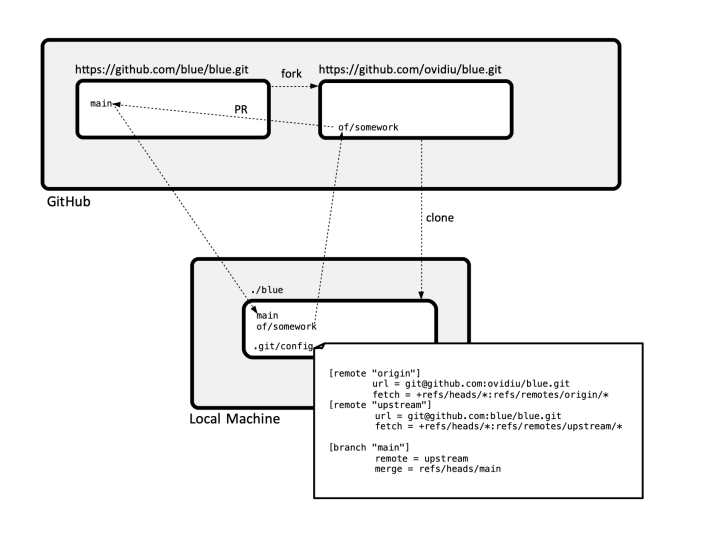Git Forked Repository Operations: Difference between revisions
No edit summary |
(→CLI) |
||
| Line 80: | Line 80: | ||
git pull | git pull | ||
</syntaxhighlight> | </syntaxhighlight> | ||
<font color=darkkhaki> | <font color=darkkhaki> | ||
To clean up branches: | To clean up branches: | ||
<syntaxhighlight lang='bash'> | <syntaxhighlight lang='bash'> | ||
git remote prune origin | |||
git remote prune upstream | git remote prune upstream | ||
</syntaxhighlight> | </syntaxhighlight> | ||
How to deal with the leftover branch in the origin repository? | |||
How to deal with the origin and upstream growing out of sync? | How to deal with the origin and upstream growing out of sync? | ||
</font> | </font> | ||
Revision as of 22:48, 1 November 2023
External
Internal
Overview
For terminology, see upstream/base and head repositories.
The typical GitHub forked repository topology is similar to:
Initial Setup
Fork
Go to GitHub UI and click on the "Fork" button at the top of the page. Use your own "personal" organization ("ovidiu") to fork into.
Clone
Clone as usual:
git clone git@github.com:ovidiu/blue.git
Establish Relationships
Setup the "upstream" Repository
Establish a direct relationship between the local clone and the "upstream" repository. This will allow to pull the latest version of branches directly from the upstream repository.
git remote add upstream git@github.com:blue/blue.git
.git/config will contain:
[remote "upstream"]
url = git@github.com:blue/blue.git
fetch = +refs/heads/*:refs/remotes/upstream/*
This will allow us to fetch directly from "upstream"
git fetch upstream
Configure the "main" Branch to Update From Upstream
git fetch upstream
git branch --set-upstream-to=upstream/main main
This will configure the local "main" branch to track upstream's "main" branch. The .git/config will look like:
[branch "main"]
remote = upstream
merge = refs/heads/main
git pull will automatically apply upstream's "main" branch changes to the local main.
PR Cycle
Send a PR
Push the commit in the head repository.
It will show up in the UI.
Click "Compare & pull request"
The UI will give you the default choice to send the PR against the base repository while "Create pull request". Use it.
Merge the PR
Upon approval, merge the PR in upstream. Usually, the repository is configured to remove the branch from where? What branch is deleted? Probably the origin's. Check.
Sync the Repository after the PR Merge
From the GitHub UI
In the fork repository UI, use "Fetch upstream" button. Then git pull from the local clone.
CLI
Assuming the local repository was set as shown above, git pull will bring the latest "main" changes and will allow us to delete the local feature branch after it was merged in upstream.
git pull
To clean up branches:
git remote prune origin
git remote prune upstream
How to deal with the leftover branch in the origin repository?
How to deal with the origin and upstream growing out of sync?
